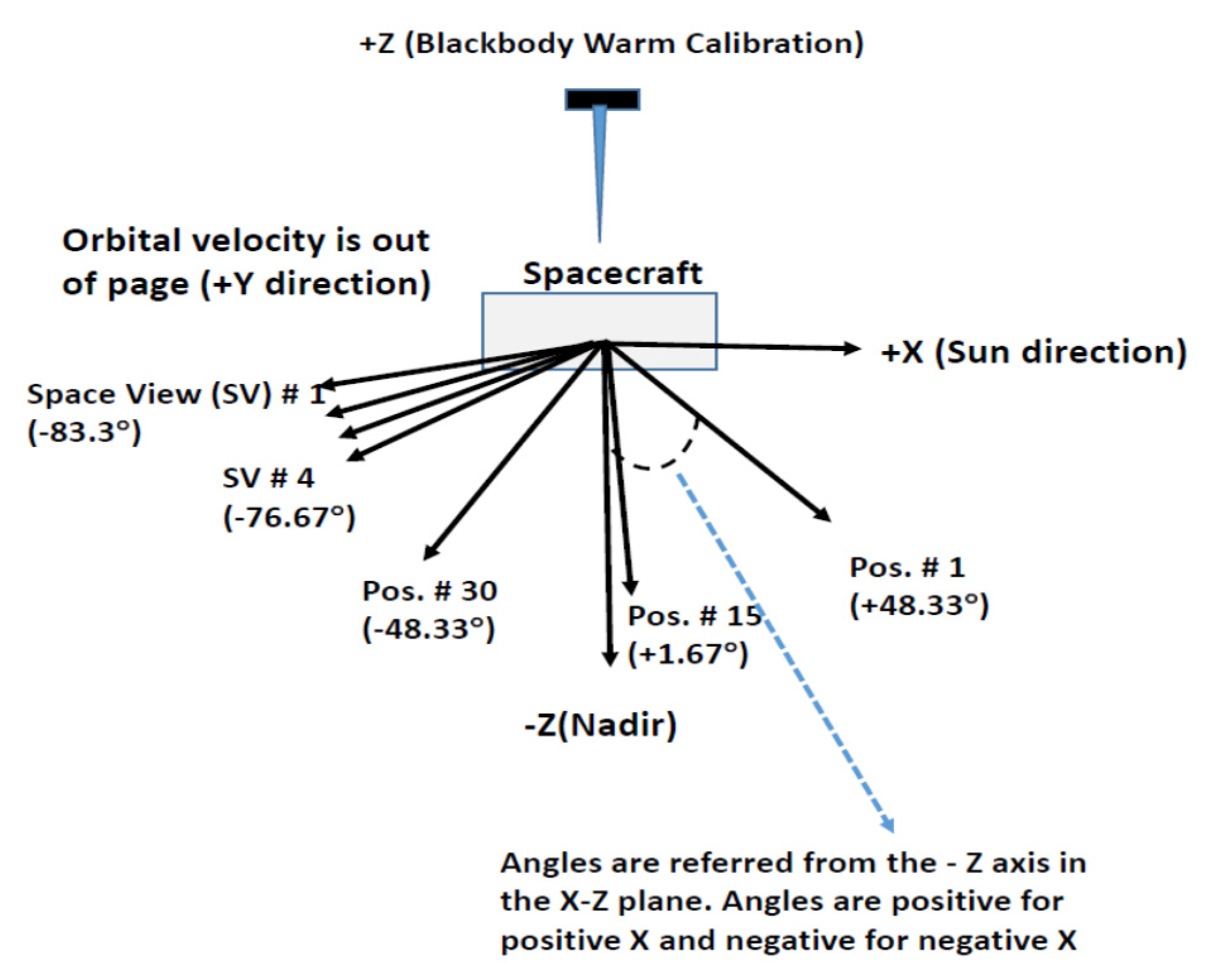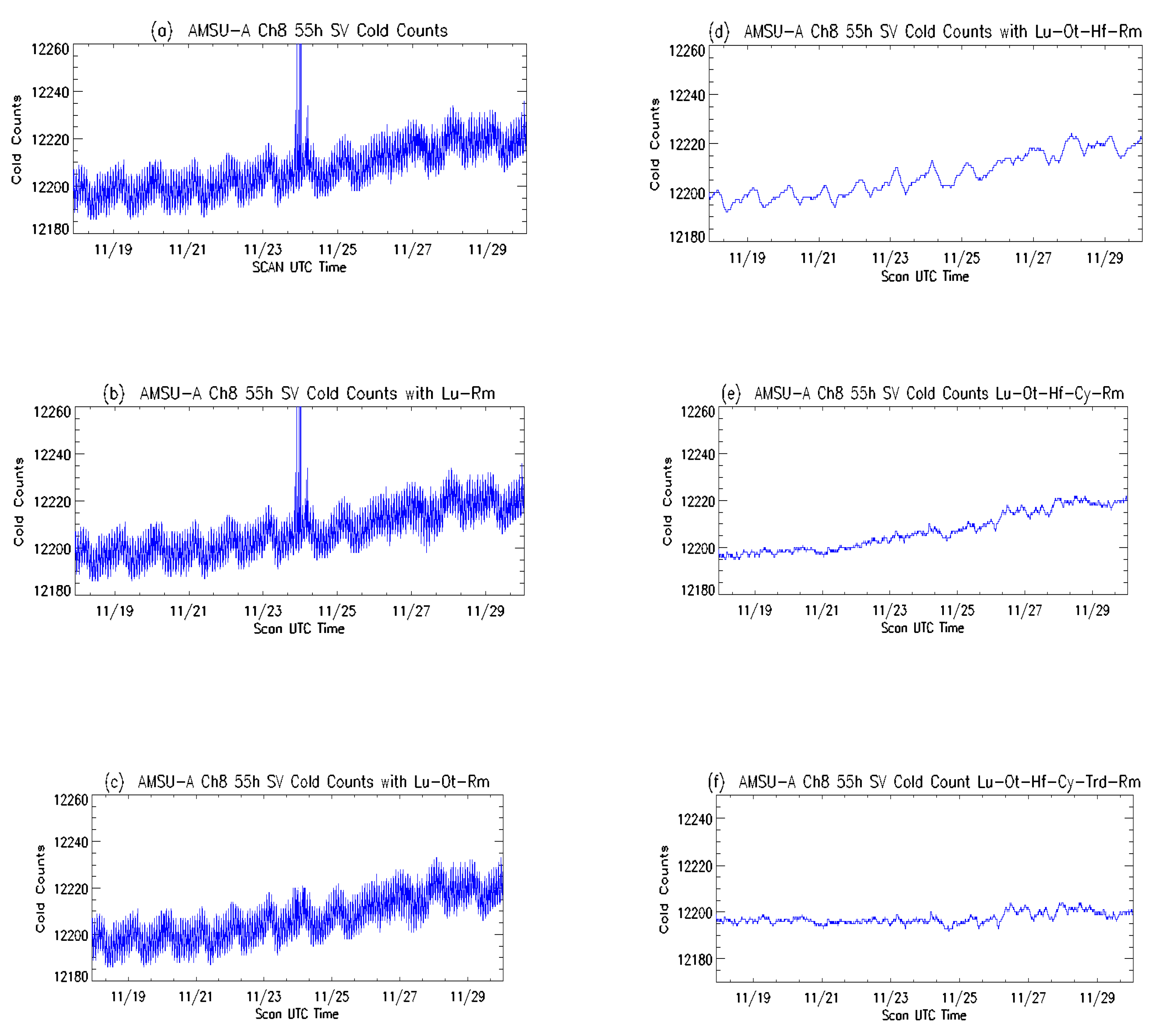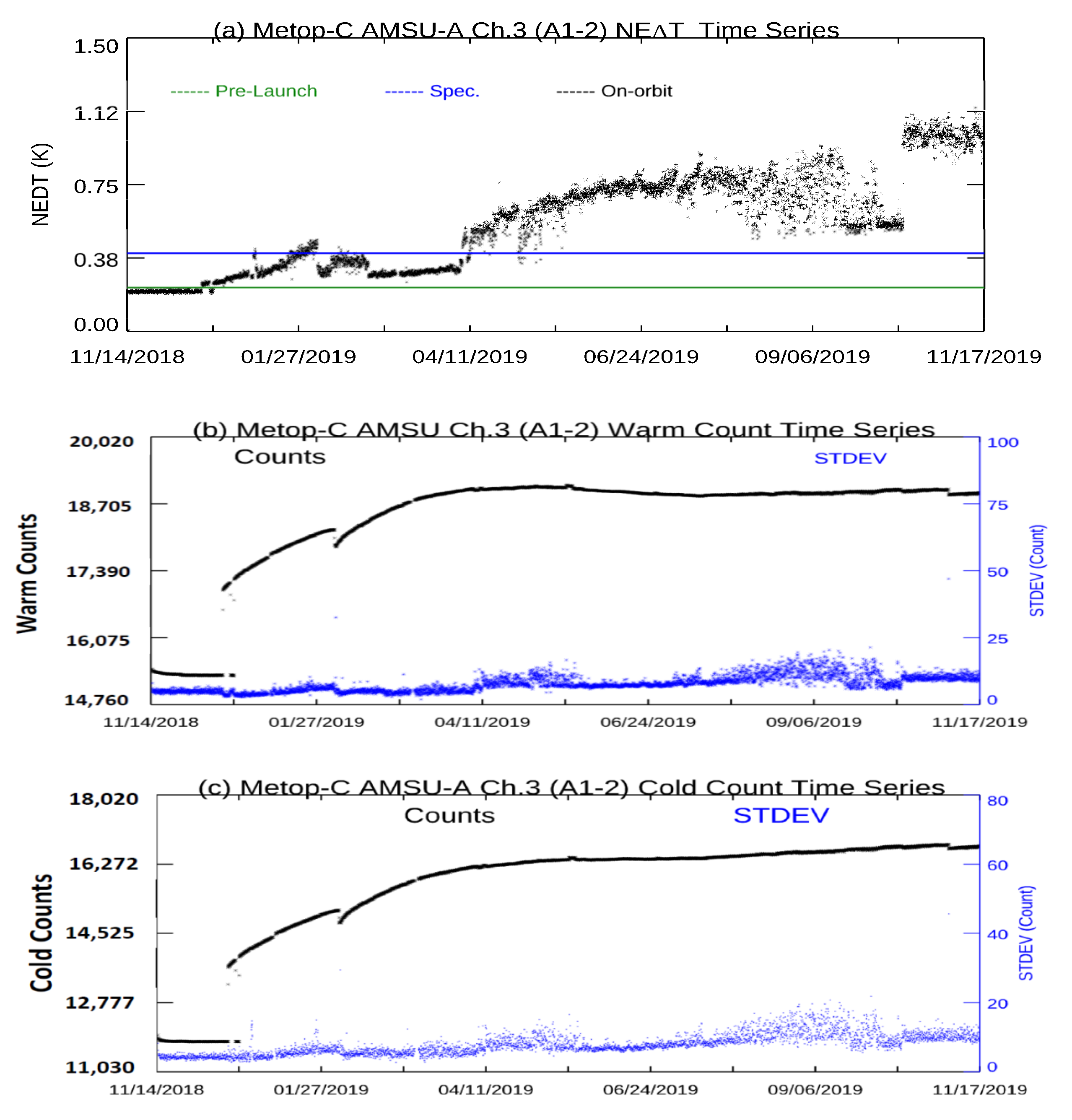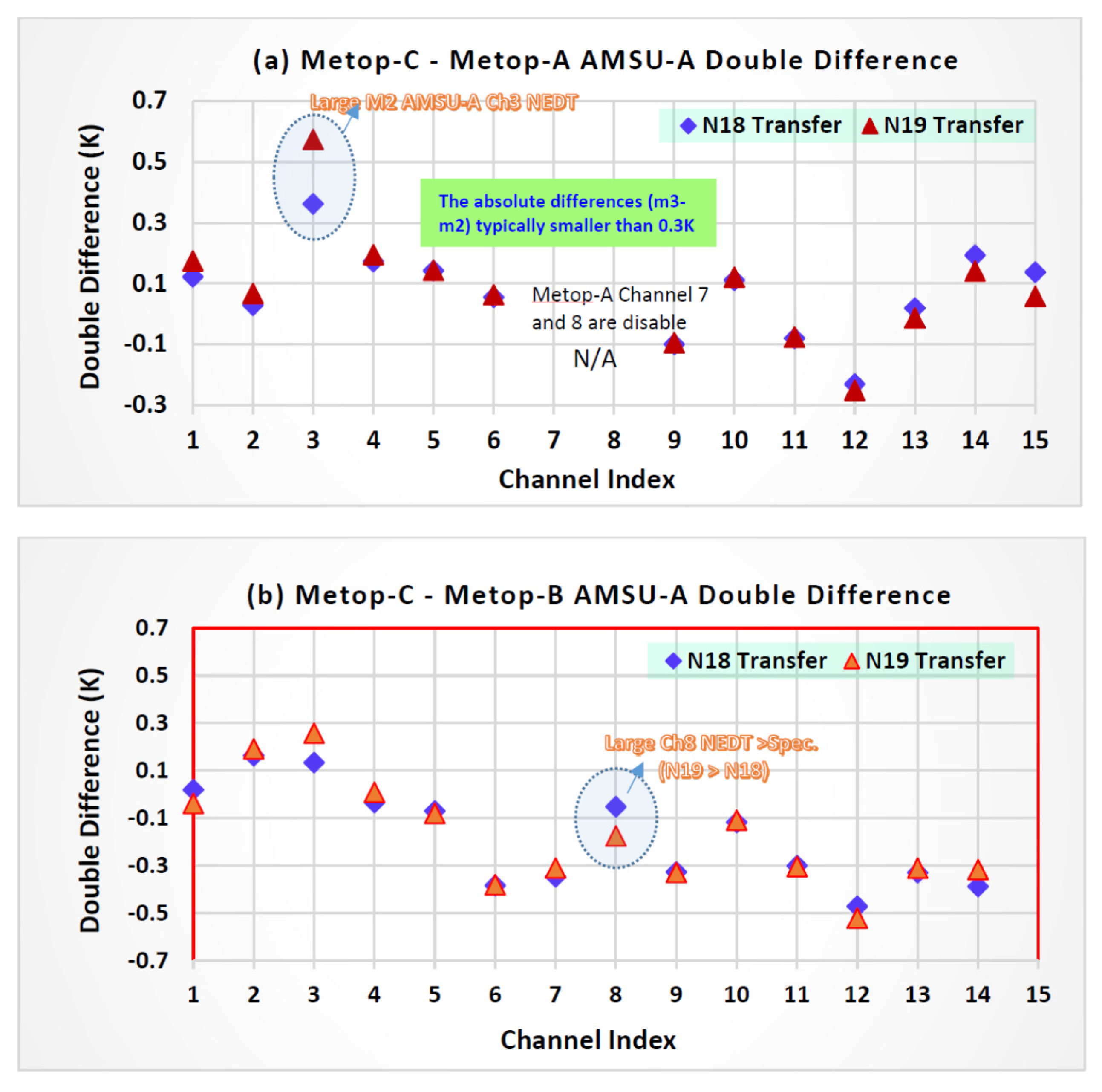Calibration and Validation of Antenna and Brightness Temperatures from Metop-C Advanced Microwave Sounding Unit-A (AMSU-A)
Abstract
1. Introduction
2. AMSU-A Instrument Description and Optimal Cold Space Position Selection
3. AMSU-A Calibration Methodology Description
3.1. Calibration Equations
3.2. Determinations of Cold Space Calibration Correction and Nonlinearity
4. Instrument Noise Performance Assessment
5. AMSU-A TDR and SDR Quality Assessment
5.1. Comparisons with CRTM Simulations
5.2. Metop-A, -B and -C Inter-Sensor Comparisons Using SNO Method
6. Summary and Conclusions
Author Contributions
Funding
Acknowledgments
Disclaimer
Conflicts of Interest
Appendix A. Radiometric Calibration Counts (Blackbody and Cold Counts)
Appendix B. Blackbody Target Temperatures
Appendix C. On-Orbit AMSU-A NEDT Methods
References
- Zou, C.; Qian, H. Prelaunch Calibration of the Advanced Microwave Sounding Unit-A Radiometer for MetOp-C; NOAA/STAR Technical Report; NOAA STAR: Silver Spring, MD, USA, 2018.
- Yan, B.; Chen, J.; Ahmad, K.; Zou, C.; Qian, H. Metop-C Advanced Microwave Sounding Unit-A (AMSU-A) TDR/SDR Beta Maturity Status; NOAA Office of Projects, Planning, and Analysis (OPPA): College Park, MD, USA, February 2019.
- Yan, B.; Chen, J.; Zou, C.; Ahmad, K.; Qian, H. Metop-C Advanced Microwave Sounding Unit-A (AMSU-A) TDR/SDR Provisional Maturity Status; NOAA Office of Projects, Planning, and Analysis (OPPA): College Park, MD, USA, April 2019.
- Yan, B.; Chen, J.; Zou, C.; Ahmad, K.; Qian, H. NOAA-20 Advanced Microwave Sounding Unit-A (AMSU-A) TDR/SDR Validated Maturity Status; NOAA Office of Projects, Planning, and Analysis (OPPA): College Park, MD, USA, August 2019.
- Yan, B.; Ahmad, K. Derivation and validation of sensor brightness temperatures for advanced microwave sounding unit-A instruments. IEEE Trans. Geosci. Remote Sens. 2020. [Google Scholar] [CrossRef]
- Northrop Grumman Electronic Systems (NGES). Calibration Log Book for AMSU-A1 SN 105; Report No. 16729; Northrop Grumman: Azusa, CA, USA, 2010. [Google Scholar]
- Boukabara, S.; Garrett, K.; Chen, W.; Iturbide-Sanchez, F.; Grassotti, C.; Kongoli, C.; Chen, R.; Liu, Q.; Yan, B.; Weng, F.; et al. MiRS: An all-weather 1dvar satellite data assimilation and retrieval system. IEEE Trans. Geosci. Remote Sens. 2011, 49, 3249–3272. [Google Scholar] [CrossRef]
- Weng, F.; Yan, B. A microwave snow emissivity model. In Proceedings of the International TOVS Study Conference-XIII, Sainte-Adèle, QC, Canada, 29 October–4 November 2003; Available online: http://library.ssec.wisc.edu/research_Resources/publications/pdfs/ITSC13/weng01_ITSC13_2003.pdf (accessed on 3 August 2020).
- Weng, F.; Zhu, T.; Yan, B. Satellite data assimilation in numerical weather prediction models. Part II: Uses of rain-affected radiances from microwave observations for hurricane vortex analysis. J. Atmos. Sci. 2007, 64, 3910–3925. [Google Scholar] [CrossRef]
- Yan, B.; Weng, F.; Meng, H. Retrieval of snow surface microwave emissivity from the advanced microwave sounding unit. J. Geophys. Res. 2008, 113, D19206. [Google Scholar] [CrossRef]
- Meng, H.; Dong, J.; Ferraro, R.; Yan, B.; Zhao, L.; Kongoli, C.; Wang, N.-Y.; Zavodsky, B. A 1DVAR-based snowfall rate retrieval algorithm for passive microwave radiometers. J. Geophys. Res. Atmos. 2017, 122, 6520–6540. [Google Scholar] [CrossRef]
- Zhu, T.; Zhang, D.; Weng, F. Impact of the advanced microwave sounding unit measurements on hurricane prediction. Mon. Wea. Rev. 2002, 130, 2416–2432. [Google Scholar] [CrossRef]
- Zou, X.L. Climate trend detection and its sensitivity to measurement precision. Adv. Meteorol. Sci. Technol. 2012, 2, 41–43. [Google Scholar]
- Yan, B.; Weng, F. Effects of microwave desert surface emissivity on AMSU-A data assimilation. IEEE Trans. Geosci. Remote. Sens. 2011, 49, 1263–1276. [Google Scholar] [CrossRef]
- Kelly, G.; Thépaut, J.-N. Evaluation of the impact of the space component of the Global Observation System through observing system experiments. ECMWF Newsl. 2017, 113, 16–28. Available online: http://www.ecmwf.int/publications/newsletters/pdf/113.pdf (accessed on 3 August 2020).
- Zou, X.L.; Qin, Z.; Weng, F. Impacts from assimilation of one data stream of AMSU-A and MHS radiances on quantitative precipitation forecasts, Q.J.R. Meteorol. Soc. 2017, 143, 731–743. [Google Scholar] [CrossRef]
- Zhu, K.; Xue, M.; Pan, Y.; Hu, M.; Benjamin, S.G.; Weygandt, S.S.; Lin, H. The impact of satellite radiance data assimilation within a frequently updated regional forecast system using a GSI-based ensemble kalman filter. Adv. Atmos. Sci. 2019, 36, 1308–1326. [Google Scholar] [CrossRef]
- Tian, M.; Zou, X.; Weng, F. Use of allan deviation for characterizing satellite microwave sounder noise equivalent differential temperature (NEDT). IEEE Geosci. Remote Sens. Lett. 2015, 12, 2477–2480. [Google Scholar] [CrossRef]
- Yan, B.; Kireev, S. A new methodology about characterizing on-orbit advanced microwave sounding unit—A (AMSU-A) earth-scene temperature noise equivalent differential temperature. IEEE Trans. Geosci. Remote Sens. 2020. in revision. [Google Scholar]
- Ohring, G.; Wielicki, B.; Spencer, R.; Emery, B.; Datla, R. Satellite instrument calibration for measuring global climate change: Report of a workshop. Bull. Amer. Meteorol. Soc. 2005, 86, 1303–1313. [Google Scholar] [CrossRef]
- Wielicki, B.; Young, D.F.; Mlynczak, M.G.; Mlynczak, M.G. Achieving climate change absolute accuracy in orbit. Bull. Am. Meteorol. Soc. 2013, 94, 1519–1539. [Google Scholar] [CrossRef]
- Zou, C.Z.; Wang, W. Intersatellite calibration of AMSU-A observations for weather and climate applications. J. Geophys. Res. 2011, 116, D23113. [Google Scholar] [CrossRef]
- Han, Y. JCSDA community radiative transfer model (CRTM)—Version 1. NOAA Tech. Rep. 2006, 122, 1–33. [Google Scholar]
- Cao, C.; Weinreb, M.; Xu, H. Predicting simultaneous nadir overpasses among polar-orbiting meteorological satellites for the intersatellite calibration of radiometers. J. Atmos. Ocean. Technol. 2004, 21, 537–542. [Google Scholar] [CrossRef]
- Iacovazzi, R.; Cao, C.; Cao, C. Reducing uncertainties of sno-estimated intersatellite amsu-a brightness temperature biases for surface-sensitive channels. J. Atmos. Oceanic Technol. 2007, 25, 1048–1054. [Google Scholar] [CrossRef]
- Yan, B.; Weng, F. Intercalibration between special sensor microwave imager/sounder and special sensor microwave imager. IEEE Trans. Geosci. Remote Sens. 2008, 46, 984–995. [Google Scholar]
- Northrop Grumman Electronic Systems (NGES). AMSU-A System Operation and Maintenance Manual for METSAT/METOP; Technique Report NAS 5-32314 CDRL 307; NGES: Linthicum Heights, MD, USA, 2010; pp. 105–109. [Google Scholar]
- Mo, T. AMSU-A antenna pattern corrections. IEEE Trans. Geosci. Remote Sens. 1999, 37, 103–112. [Google Scholar]
- Mo, T. Prelaunch calibration of the advanced microwave sounding unit-A for NOAA-K. IEEE Trans. Microw. Theory Technol. 1996, 44, 1460–1469. [Google Scholar] [CrossRef]
- Mo, T. Calibration of the Advanced Microwave Sounding Unit-A Radiometer for MetOp-A; NOAA Technical Report NESDIS 121; NOAA NESDIS: Silver Spring, MD, USA, 2006.
- Mo, T.; Kigawa, S. A study of lunar contamination and onorbit performance of the NOAA-18 advanced microwave sounding unit-A. J. Geophys. Res. 2007, 112, D20124. [Google Scholar] [CrossRef]
- Mo, T. Postlaunch calibration of the MetOp-A advanced microwave sounding unit-A. IEEE Trans. Geosci. Remote Sens. 2008, 46, 3581–3600. [Google Scholar] [CrossRef]
- Mo, T.; Weinreb, M.; Grody, N.; Wark, D. AMSU-A Engineering Model Calibration; NOAA Technical Report NESDIS 68; NOAA NESDIS: Silver Spring, MD, USA, 1993.
- Weng, F.; Zou, X.; Sun, N.; Yang, H.; Tian, M.; Blackwell, W.J.; Wang, X.; Lin, L.; Anderson, K. Calibration of Suomi national polar-orbiting partnership advanced technology microwave sounder. J. Geophys. Res. 2013, 118, 1–14. [Google Scholar] [CrossRef]
- Weng, F.; Zou, X. Errors from Rayleigh–Jeans approximation in satellite microwave radiometer calibration systems. Appl. Opt. 2013, 52, 505–508. [Google Scholar] [CrossRef]
- Northrop Grumman Electronic Systems (NGES). Calibration Log Book for the Advanced Microwave Sounding Unit-A (AMSU-A); Report#10481A; Northrop Grumman Electronic Systems: Aerojet, Azusa, CA, USA, 1995. [Google Scholar]
- Northrop Grumman Electronic Systems (NGES). Calibration Log Book for AMSU-A2 SN 107; Report No. 15267; Northrop G Grumman: Azusa, CA, USA, 2008. [Google Scholar]
- Hans, I.; Burgdorf1, M.; John, V.O.; Mittaz, J.; Buehler, S.A. Noise performance of microwave humidity sounders over their life time. Atmos. Meas. Tech. Discuss. 2017, 10, 4927–4945. [Google Scholar] [CrossRef]
- Allan, D.W. Statistics of atomic frequency standards. Proc. IEEE 1966, 54, 221–230. [Google Scholar] [CrossRef]
- Allan, D.W. Should classical variance be used as a basic measure in standards metrology? IEEE Trans. Instrum. Meas. 1987, 36, 646–654. [Google Scholar] [CrossRef]
- Ding, S.; Yang, P.; Weng, F.; Liu, Q.; Han, Y.; van Delst, P.; Li, J.; Baum, B. Validation of the community radiative transfer model. J. Quant. Spectrosc. Radiat. Transf. 2011, 112, 1050–1064. [Google Scholar] [CrossRef]
- Johnson, B.; Zhu, T.; Chen, M.; Ma, Y.; Auligné, T. The Community Radiative Transfer Model (CRTM). In Proceedings of the 21st International TOVS Study Conference, Darmstadt, Germany, 29 November 2017; Available online: https://cimss.ssec.wisc.edu/itwg/itsc/itsc21/program/29november/0900_1.01_JCSDA_CRTM_ITSC-21_BJohnson_final.pdf (accessed on 3 August 2020).
- Liu, Q.; Weng, F.; English, S.J. An improved fast microwave water emissivity model. IEEE Trans. Geosci. Remote Sens. 2011, 49, 1238–1250. [Google Scholar] [CrossRef]
- Bormann, N.; Geer, A.; English, S.J. Evaluation of the Microwave Ocean Surface Emissivity Model FASTEM-5 in the IFS; Technical Report Technical Memorandum 667; ECMWF: Reading, UK, 2012. [Google Scholar]
- Ingleby, B. An Assessment of Different Radiosonde Types 2015/2016. ECMWF Technical Memoranda, ECMWF Shinfield Park Reading RG2 9AX United Kingdom: 2017. Available online: https://www.ecmwf.int/en/publications (accessed on 3 August 2020).
- Carminati, F.; Migliorini1, S.; Ingleby, B.; Bell, W.; Lawrence, H.; Newman, S.; Hocking, J.; Smith, A. Using reference radiosondes to characterise NWP model uncertainty for improved satellite calibration and validation. Atmos. Meas. Tech. 2019, 12, 83–106. [Google Scholar] [CrossRef]
- Weng, F.; Zhao, L.; Ferraro, R.; Poe, G.; Li, X.; Grody, N. Advanced microwave sounding unit cloud and precipitation algorithms. Radio Sci. 2003, 38, 8086–8096. [Google Scholar] [CrossRef]
- Goldberg, M.D.; Crosby, D.S.; Zhou, L.H. The limb adjustment of AMSU-A observations. J. Appl. Meteorol. 2001, 40, 70–83. [Google Scholar] [CrossRef]
- Yang, W.; Meng, H.; Ferraro, R. Cross-scan asymmetry of AMSU-A window channels: Characterization, correction, and verification. IEEE Trans. Geosci. Remote Sens. 2013, 51, 1514–1530. [Google Scholar] [CrossRef]









| Channel Index | Center Frequency (MHz) | Central Frequency Stability (MHz) | Bandwidth (MHz) | Polarization | Measured 3-db Beamwidth 1,2 (°) | Temperature Sensitivity (NEΔT) (K) |
|---|---|---|---|---|---|---|
| 1 | 23,800 | ±10 | 270 | V | 3.48 | 0.3 |
| 2 | 31,400 | ±10 | 180 | V | 3.52 | 0.3 |
| 3 | 50,300 | ±10 | 180 | V | 3.64 | 0.4 |
| 4 | 52,800 | ±5 | 400 | V | 3.40 | 0.25 |
| 5 | 53,596 ± 115 3 | ±5 | 170 | H | 3.60 | 0.25 |
| 6 | 54,400 | ±5 | 400 | H | 3.44 | 0.25 |
| 7 | 54,940 | ±5 | 400 | V | 3.44 | 0.25 |
| 8 | 55,500 | ±10 | 330 | H | 3.44 | 0.25 |
| 9 | f0 = 57,290.344 | ±0.5 | 330 | H | 3.32 | 0.25 |
| 10 | f0 ± 217 3 | ±0.5 | 78 | H | 3.325 | 0.4 |
| 11 | f0 ± 322.2 ± 48 4 | ±1.2 | 36 | H | 3.32 | 0.4 |
| 12 | f0 ± 322.2 ± 22 4 | ±1.2 | 16 | H | 3.32 | 0.6 |
| 13 | f0 ± 322.2 ± 10 4 | ±0.5 | 8 | H | 3.32 | 0.8 |
| 14 | f0 ± 322.2 ± 4.5 4 | ±0.5 | 3 | H | 3.32 | 1.2 |
| 15 | 89,000 | ±130 | 1500 | V | 3.56 | 0.5 |
| Channel | SV1 * | SV2 * | SV4 * | SV 3 * | SV1n * | Optimal SV |
|---|---|---|---|---|---|---|
| 1 | 11,862.49 | 11,862.90 | 11,865.61 | 11,863.34 | 11,862.85 | SV1 |
| 2 | 11,351.19 | 11,351.23 | 11,353.70 | 11,350.86 | 11,351.80 | SV3 |
| 3 | 11,794.02 | 11,791.19 | 11,794.24 | 11,789.59 | 11,785.46 | SV1n |
| 4 | 12,694.09 | 12,694.11 | 12,696.86 | 12,695.06 | 12,692.76 | SV1n |
| 5 | 13,123.09 | 13,123.91 | 13,125.99 | 13,125.03 | 13,125.80 | SV1 |
| 6 | 12,335.72 | 12,335.36 | 12,336.37 | 12,337.13 | 12,337.19 | SV2 |
| 7 | 12,813.11 | 12,807.50 | 12,809.56 | 12,810.05 | 12,813.40 | SV2 |
| 8 | 12,196.05 | 12,196.08 | 12,196.09 | 12,200.60 | 12,199.81 | SV1 |
| 9 | 12,284.01 | 12,281.09 | 12,278.17 | 12,278.76 | 12,280.33 | SV4 |
| 10 | 12,184.44 | 12,183.84 | 12,183.69 | 12,186.46 | 12,189.38 | SV4 |
| 11 | 13,059.05 | 13,061.89 | 13,060.14 | 13,062.13 | 13,066.32 | SV1 |
| 12 | 12,820.44 | 12,821.88 | 12,819.51 | 12,819.92 | 12,823.72 | SV4 |
| 13 | 13,287.03 | 13,288.95 | 13,286.26 | 13,285.88 | 13,288.63 | SV3 |
| 14 | 12,760.81 | 12,764.91 | 12,764.76 | 12,766.90 | 12,771.17 | SV1 |
| 15 | 13,843.62 | 13,843.38 | 13,842.72 | 13,848.32 | 13,850.08 | SV4 |
| Channel Index | ||
|---|---|---|
| 1 | 0.040 | 1.162 |
| 2 | 0.069 | 1.107 |
| 3 | 0.176 | 1.994 |
| 4 | 0.194 | 2.269 |
| 5 | 0.200 | 2.089 |
| 6 | 0.206 | 1.253 |
| 7 | 0.210 | 1.615 |
| 8 | 0.214 | 1.903 |
| 9–14 | 0.228 | 1.138 |
| 15 | 0.537 | 0.754 |
| Ch. | FC (%) | FE (%) | FSAT (%) | |||||||||
|---|---|---|---|---|---|---|---|---|---|---|---|---|
| SV1 | SV2 | SV3 | SV4 | SV1 | SV2 | SV3 | SV4 | SV1 | SV2 | SV3 | SV4 | |
| 1 | 99.06 | 99.00 | 99.08 | 99.09 | 0.49 | 0.54 | 0.5 | 0.53 | 0.52 | 0.49 | 0.48 | 0.44 |
| 2 | 99.23 | 99.17 | 99.25 | 99.26 | 0.36 | 0.43 | 0.39 | 0.41 | 0.42 | 0.39 | 0.37 | 0.34 |
| 3 | 98.45 | 98.31 | 98.45 | 98.45 | 0.85 | 1.00 | 0.88 | 0.90 | 0.70 | 0.68 | 0.67 | 0.64 |
| 4 | 98.19 | 98.04 | 98.21 | 98.22 | 0.97 | 1.14 | 1.00 | 1.02 | 0.84 | 0.81 | 0.80 | 0.77 |
| 5 | 98.52 | 98.40 | 98.54 | 98.55 | 0.87 | 1.01 | 0.90 | 0.92 | 0.63 | 0.60 | 0.58 | 0.55 |
| 6 | 98.99 | 98.93 | 99.00 | 99.00 | 0.53 | 0.61 | 0.55 | 0.57 | 0.49 | 0.47 | 0.46 | 0.44 |
| 7 | 98.67 | 98.66 | 98.70 | 98.72 | 0.68 | 0.71 | 0.71 | 0.73 | 0.66 | 0.63 | 0.61 | 0.57 |
| 8 | 98.76 | 98.60 | 98.76 | 98.76 | 0.79 | 0.95 | 0.82 | 0.83 | 0.48 | 0.46 | 0.44 | 0.42 |
| 9–14 | 99.07 | 99.02 | 99.09 | 99.09 | 0.48 | 0.54 | 0.50 | 0.52 | 0.46 | 0.45 | 0.43 | 0.41 |
| 15 | 99.52 | 99.49 | 99.52 | 99.52 | 0.27 | 0.27 | 0.27 | 0.27 | 0.27 | 0.26 | 0.25 | 0.25 |
| Ch. # | 1st Instrument Temperature | 2nd Instrument Temperature | 3rd Instrument Temperature | |||
|---|---|---|---|---|---|---|
| 1 | 5.802 | 5.600 | 5.769 | |||
| 2 | 2.236 | 2.192 | 2.145 | |||
| 3 | 0.096 | 0.100 | −0.076 | |||
| 4 | 0.881 | 1.005 | 0.969 | |||
| 5 | 0.597 | 0.724 | 0.597 | |||
| 6 | 3.309 | 2.849 | 2.146 | |||
| 7 | 3.180 | 2.698 | 2.011 | |||
| 8 | 0.574 | 0.670 | 0.569 | |||
| PLLO#1 | PLLO#2 | PLLO#1 | PLLO#2 | PLLO#1 | PLLO#2 | |
| 9 | 3.011 | 2.988 | 2.598 | 2.594 | 2.02 | 2.248 |
| 10 | 3.391 | 3.298 | 2.915 | 2.927 | 2.27 | 2.517 |
| 11 | 3.031 | 3.047 | 2.748 | 2.801 | 2.225 | 2.461 |
| 12 | 3.115 | 3.184 | 2.915 | 2.942 | 2.426 | 2.659 |
| 13 | 3.106 | 3.107 | 2.817 | 2.944 | 2.43 | 2.66 |
| 14 | 3.075 | 3.157 | 3.007 | 3.035 | 2.4 | 2.773 |
| 15 | 1.216 | 0.990 | 0.710 | |||
© 2020 by the authors. Licensee MDPI, Basel, Switzerland. This article is an open access article distributed under the terms and conditions of the Creative Commons Attribution (CC BY) license (http://creativecommons.org/licenses/by/4.0/).
Share and Cite
Yan, B.; Chen, J.; Zou, C.-Z.; Ahmad, K.; Qian, H.; Garrett, K.; Zhu, T.; Han, D.; Green, J. Calibration and Validation of Antenna and Brightness Temperatures from Metop-C Advanced Microwave Sounding Unit-A (AMSU-A). Remote Sens. 2020, 12, 2978. https://doi.org/10.3390/rs12182978
Yan B, Chen J, Zou C-Z, Ahmad K, Qian H, Garrett K, Zhu T, Han D, Green J. Calibration and Validation of Antenna and Brightness Temperatures from Metop-C Advanced Microwave Sounding Unit-A (AMSU-A). Remote Sensing. 2020; 12(18):2978. https://doi.org/10.3390/rs12182978
Chicago/Turabian StyleYan, Banghua, Junye Chen, Cheng-Zhi Zou, Khalil Ahmad, Haifeng Qian, Kevin Garrett, Tong Zhu, Dejiang Han, and Joseph Green. 2020. "Calibration and Validation of Antenna and Brightness Temperatures from Metop-C Advanced Microwave Sounding Unit-A (AMSU-A)" Remote Sensing 12, no. 18: 2978. https://doi.org/10.3390/rs12182978
APA StyleYan, B., Chen, J., Zou, C.-Z., Ahmad, K., Qian, H., Garrett, K., Zhu, T., Han, D., & Green, J. (2020). Calibration and Validation of Antenna and Brightness Temperatures from Metop-C Advanced Microwave Sounding Unit-A (AMSU-A). Remote Sensing, 12(18), 2978. https://doi.org/10.3390/rs12182978





